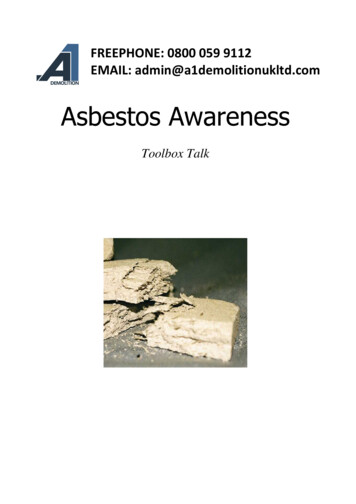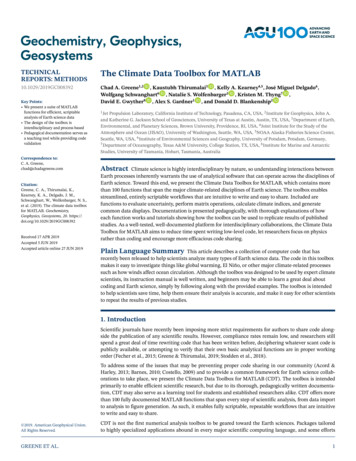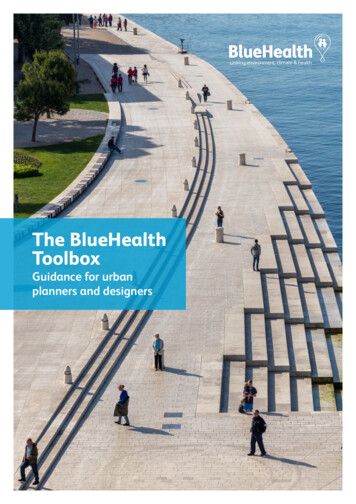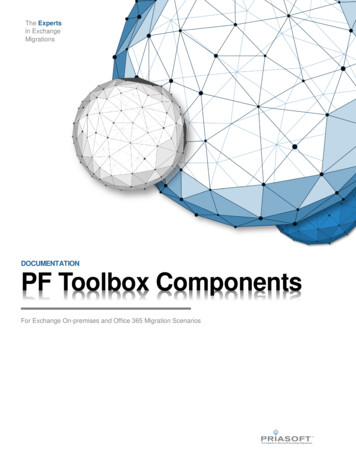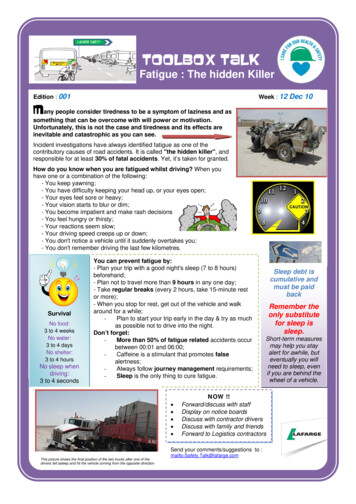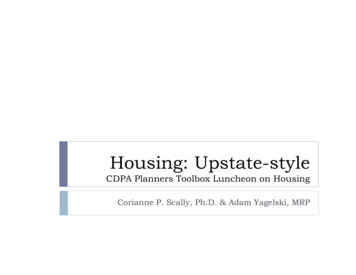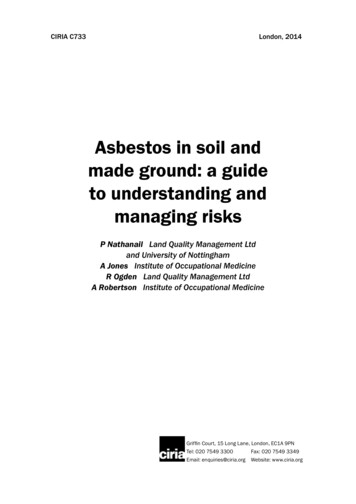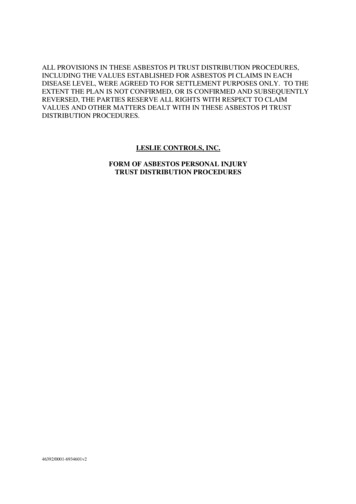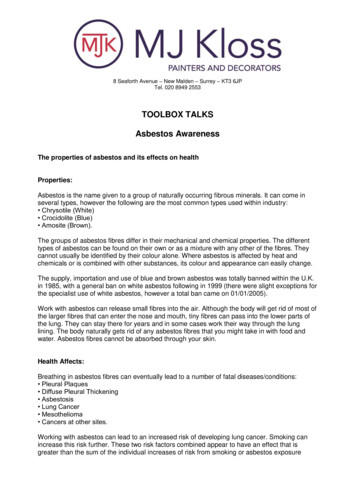
Transcription
8 Seaforth Avenue – New Malden – Surrey – KT3 6JPTel. 020 8949 2553TOOLBOX TALKSAsbestos AwarenessThe properties of asbestos and its effects on healthProperties:Asbestos is the name given to a group of naturally occurring fibrous minerals. It can come inseveral types, however the following are the most common types used within industry: Chrysotile (White) Crocidolite (Blue) Amosite (Brown).The groups of asbestos fibres differ in their mechanical and chemical properties. The differenttypes of asbestos can be found on their own or as a mixture with any other of the fibres. Theycannot usually be identified by their colour alone. Where asbestos is affected by heat andchemicals or is combined with other substances, its colour and appearance can easily change.The supply, importation and use of blue and brown asbestos was totally banned within the U.K.in 1985, with a general ban on white asbestos following in 1999 (there were slight exceptions forthe specialist use of white asbestos, however a total ban came on 01/01/2005).Work with asbestos can release small fibres into the air. Although the body will get rid of most ofthe larger fibres that can enter the nose and mouth, tiny fibres can pass into the lower parts ofthe lung. They can stay there for years and in some cases work their way through the lunglining. The body naturally gets rid of any asbestos fibres that you might take in with food andwater. Asbestos fibres cannot be absorbed through your skin.Health Affects:Breathing in asbestos fibres can eventually lead to a number of fatal diseases/conditions: Pleural Plaques Diffuse Pleural Thickening Asbestosis Lung Cancer Mesothelioma Cancers at other sites.Working with asbestos can lead to an increased risk of developing lung cancer. Smoking canincrease this risk further. These two risk factors combined appear to have an effect that isgreater than the sum of the individual increases of risk from smoking or asbestos exposure
alone. Ex-smokers have been shown to be at a significantly lower excess risk than currentsmokers.There are no known cures for asbestos-related diseases and they will generally appear manyyears after first exposure, which can vary between 15 and 60 years. The symptoms mayinclude: Shortness of breath A cough or a change in cough pattern Blood in the sputum (fluid) coughed up from the lungs Pain in the chest or abdomen Difficulty in swallowing or prolonged hoarseness and or Significant weight loss.There are approximately 3,500 deaths a year due to asbestos related diseases, with this due toincrease to 10,000 by 2020.If asbestos containing material is intact and in a position where it cannot easily be damaged, itwill not pose a risk to health by releasing fibres into the air.Many of the people currently suffering from asbestos related diseases formally worked in thebuilding trade. They were exposed to asbestos fibres in their day to day work with asbestoscontaining materials or because work with asbestos was carried out near them. Therefore, takenote of the following guidance and take the necessary action if you suspect that you are workingon or near asbestos containing materials.The Types, Uses and likely Occurrence of Asbestos and Asbestos Containing Materials (ACMs)in Buildings and Plant:Although asbestos should have not been used as a new building material in any form since atleast 1999, many thousands of tonnes of it were used in buildings in the past. A large amount ofasbestos is still out there and you cannot easily identify it from its appearance.Asbestos is likely to be in a building if: It was built or refurbished between 1950 and 1980 and particularly; If it also has a steel frame; and/or It has boilers with thermal insulation. But you also need to bear in mind that asbestos cementhas also been widely used as abuilding material since the 1950’s.Some ACMs are more vulnerable to damage and more likely to give off fibres than others. Ingeneral, the materials which contain a high percentage of asbestos are more easily damaged.The list below is roughly in order of ease of fibre release (with the highest potential fibre releasefirst). Sprayed coatings, lagging and insulating board are more likely to contain blue or brownasbestos. Asbestos insulation and lagging can contain up to 85% asbestos and are most likelyto give off fibres. Work with asbestos insulating board can result in equally high fibre release ifpower tools are used. On the other hand, asbestos cement contains only 10% - 15% asbestos.The asbestos is tightly bound into the cement and the material will only give off fibres if it isbadly damaged or broken.2
You are most likely to come across asbestos in these materials: Sprayed asbestos and asbestos loose packing - generally used as fire breaks in ceiling voids. Moulded or preformed lagging - generally used in thermal insulation of pipes and boilers. Sprayed asbestos - generally used as fire protection in ducts, firebreaks, panels, partitions,soffit boards, ceiling panels and around structural steel work.3
Insulating boards used for fire protection, thermal insulation, partitioning and ducts. Some ceiling tiles Millboard, paper and paper products used for insulation of electrical equipment. Asbestospaper has also been used as a fire-proof facing on wood fibreboard.4
Asbestos cement products, which can be fully or semi-compressed into flat or corrugatedsheets. Corrugated sheets are largely used as roofing and wall cladding. Other asbestoscement products include gutters, rainwater pipes and water tanks. Certain textured coatings. Bitumen roofing material.5
Vinyl or thermoplastic floor tiles.Remember, although these are the most likely uses and places where asbestos will be found,asbestos was used in many other materials. If you are in doubt, it is safer to presume that amaterial contains asbestos, unless there is strong evidence that it does not.The General Procedures to be followed to deal with an emergency e.g. an uncontrolled releaseof asbestos dust into the workplaceIn any circumstance where there is an accidental discovery or uncontrolled release of asbestosinto the workplace then measures, including emergency procedures, should be in place to limitexposure and the risks to health. Such procedures should include means of raising the alarmand procedures for evacuation, which should be tested and practiced at regular intervals. Thecause of the uncontrolled release should be identified, and adequate control regained as soonas possible.Procedure 1The following steps should be followed if an un-damaged asbestos containing material isdiscovered during a working process: 1. Discover ACM, stop work immediately 2. Keepeveryone else out of the work area 3. Report problem to the person in charge as soon aspossible 4. Put up a warning sign ‘possible asbestos contamination’.Procedure 2If you discover an ACM in a bad condition or actually damage the ACM during the work activity,the following procedures will need to be followed: 1. Discover damaged ACM, stop workimmediately 2. Keep everyone else out of the work area 3. Is there dust or debris on clothing (ifno, follow procedure 1) 4. Remove the clothing and put it into a plastic bag 5. Try to washthoroughly straight away or if the facilities are provided take a shower 6. Leave the washingfacilities clean 7. Report the problem to the person in charge as soon as possible 8. Put up awarning sign ‘possible asbestos contamination’.Step 3 of Procedure 1 and step 7 of Procedure 2 will require that you contact the site foremanas soon as possible. The site foreman will then contact head office and the site contact to informthem of the discovery and the procedures that had been followed. Head office will then liaisewith the client to arrange for a sample to be analysed and the work area to be cleaned up ifnecessary. No-one will be allowed to re-enter the contaminated area for any reason until a6
clearance / re-occupation certificate has been issued to the client by the appropriate asbestosanalysing / air monitoring company.How to Avoid Risks from AsbestosThere are some simple procedures to be followed in order to help reduce the risk ofemployees coming into contact with asbestos. Owners and occupiers of non-domesticpremises, who have maintenance and repair responsibilities for those premises, have a dutyunder the Control of Asbestos Regulations 2012 to assess the premises for the presence ofasbestos and the condition of that asbestos (this duty has been enforced since 21st November2004 under the Control of Asbestos at Work Regulations 2002). Where asbestos is present thedutyholder must ensure that the risk from the asbestos is assessed, that a written planidentifying where that asbestos is located is prepared and that measures to manage the riskfrom the asbestos are set out in that plan and are implemented.If the non-domestic premise does contain asbestos containing materials there is no legalrequirement for the asbestos to be removed. The owner/occupier will need to assess thecondition of the product and then decide whether they will remove it or whether it will stay inplace. If the ACM does stay in place the duty holder will need to ensure that it is either in a goodcondition or alternatively arrange for the product to be enclosed / sealed / encapsulated orrepaired.Therefore, before any work takes place on site, the site foreman or senior operative will requestto see the Asbestos register for that site (please note, not all sites will have a register, pleasesee section 1 below). The register will provide information on the location and condition of anyasbestos containing material on that site. If the register details that asbestos containing materialis present in the area that you are scheduled to work in, the site foreman/senior operative willcontact head office for further confirmation on whether the work is to continue or whetheralterations are to be made to the safe systems of work which were to be followed.Section 1Not all sites will have an asbestos register, this could be the case in a number of situations; 1.The site is too young for it to contain asbestos e.g. it was built after 1999, 2. The building willobviously not contain asbestos e.g. a steel built industrial unit 3. The site itself has had allasbestos removed.If a site falls under category 1 or 2, remain cautious. There could be situations where a buildingcontractor may have installed ACM’s that they still had in stock. Therefore, if you do comeacross a suspect material, follow procedures 1 or 2.If a site falls under situation 3, ask for written confirmation / evidence that the asbestos hasbeen removed by a licensed contractor.ConclusionAll exposures to asbestos should be avoided, however, that does not mean that you shouldnecessarily worry about a one-off exposure. From time to time, accidental exposures toasbestos may occur and can be a cause of much concern and distress to the individualsconcerned. Your risk of developing an asbestos-related disease depends how much asbestosyou are exposed to, for how long and on how many different occasions. A one-off short termexposure is unlikely to be of concern, but each time you are exposed, the risk increasesa little bit more. Think of this like smoking. The more times you smoke, the greater your risk ofdeveloping cancer.If in doubt: STOP WORK, CLOSE AREA OFF and NOTIFY PERSON IN CHARGE.7
Sign Off SheetI have had the toolbox talk regarding Asbestos Awareness read and explained to me and Iunderstand the contents of this onsite training.Anything I did not understand has been explained to me to my satisfaction.I agree to follow the Asbestos awareness guidance and understand that any control proceduresare provided for my safety and the safety of others.Print NameSignedDate8
TOOLBOX TALKS Asbestos Awareness The properties of asbestos and its effects on health Properties: Asbestos is the name given to a group of naturally occurring fibrous minerals. It can come in . I have had the toolbox talk regarding Asbestos Awareness read and explained to me and I
